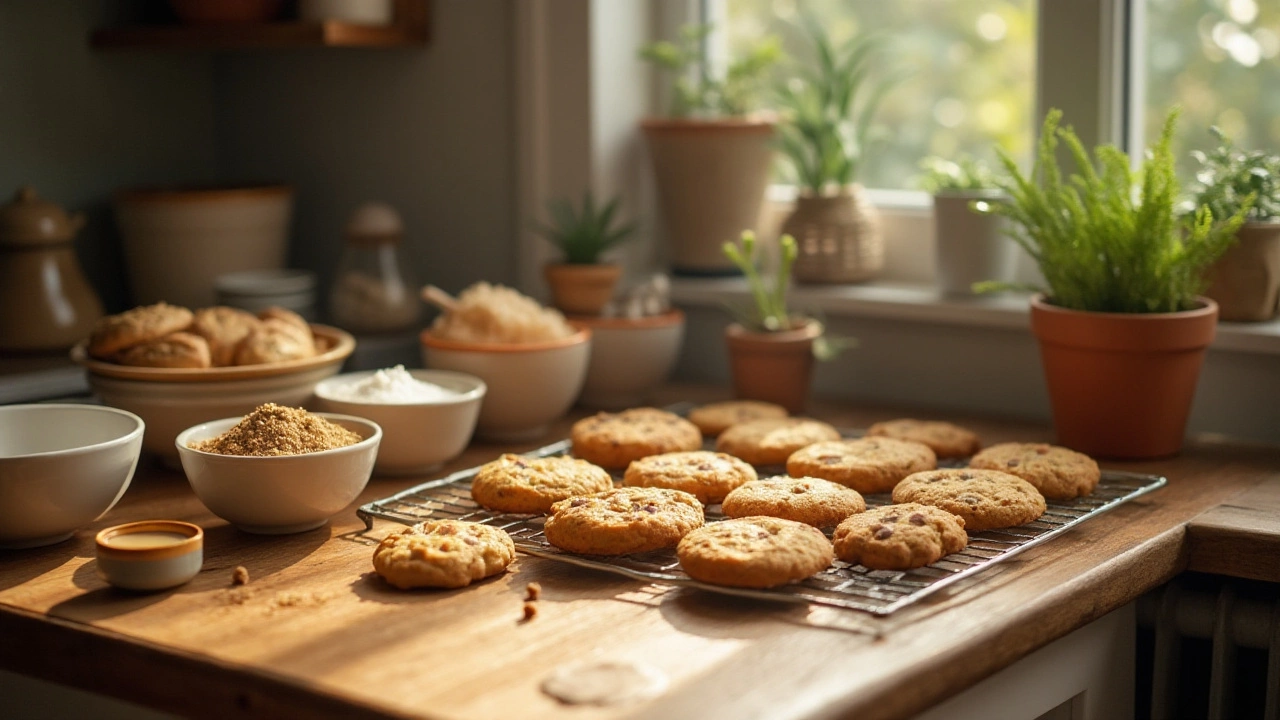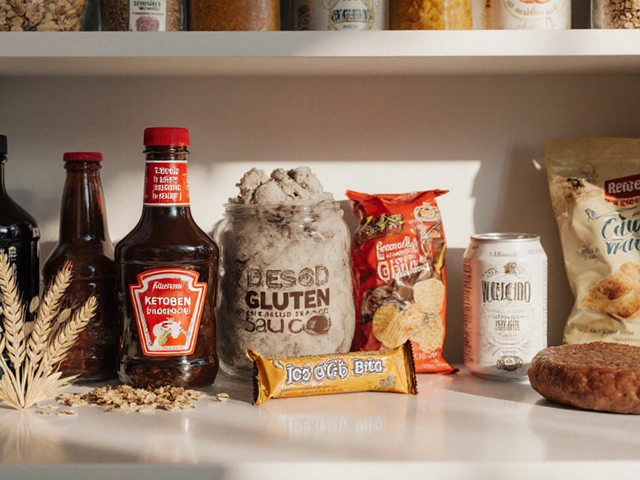
There's a certain magic in baking—especially when it comes to cookies. The thought of freshly baked cookies evokes warmth and delight, a treat that beckons fond memories of home and care. Yet, what if during a baking spree, the realization dawns that there is not a pinch of brown sugar left in the pantry? Is it truly necessary to hit pause on your cookie craving, or could you soldier on without this kitchen staple?
Brown sugar, with its signature molasses content, brings more than just sweetness to cookies. It plays an integral part in color, taste, and texture. But take heart, for the world of baking is forgiving and flexible. Not only are there substitutes, but with some thoughtful tweaks, your cookies can come out of the oven just as blissful.
Within this article, we are set to navigate through the significance of brown sugar, present alternative options that do justice to your recipe, and furnish you with practical tips. Achieving that perfect balance of chewy, crisp, and full-flavored cookies is an art, and with the right know-how, it's an art you can master without brown sugar.
- The Role of Brown Sugar in Cookies
- Common Alternatives and Their Effects
- Tips for Baking Without Brown Sugar
- Recipes to Try
- Balancing Flavor and Texture
The Role of Brown Sugar in Cookies
Baking brings a science as much as it does creativity, especially when it comes to crafting the delightful cookie. The name 'brown sugar' conjures a picture of those moist, golden crystals that melt into the dough, but its role is more than just sweetness. Indeed, brown sugar is a key player in defining the texture and color of baked goods. Because of its molasses content, it lends a chewy texture to cookies, which many find irresistible. Compared to white sugar, which is drier, brown sugar attracts moisture and helps retain it during baking, creating that soft cookie texture.
The chemistry of brown sugar goes even deeper. Its molasses component is acidic, which means it reacts beneficially with baking soda, a base ingredient in many baking recipes. This reaction generates carbon dioxide, a gas that helps baked goods rise, contributing to the light and soft crumb that characterizes the best cookie recipes. In addition to providing this texture, molasses in brown sugar also accounts for a richer, more complex flavor profile. A cookie made with brown sugar often carries a deeper, almost caramel-like taste, which adds to the depth of the cookie.
Interestingly, the molasses in brown sugar gives cookies a darker hue. This natural coloring is why cookies made with brown sugar appear earthy and warm in tone. Those visual cues often signify to the eater that what awaits is a treat more indulgent and flavorful. As cookbook author and baking expert, Maida Heatter once said,
"A well-baked cookie is the soul of the kitchen; it is complete comfort in one's hand."
Omitting brown sugar isn't a sacrilege in baking, but understanding that it brings distinct properties to the table is crucial. Bakers who care for that moist texture and caramel notes look to brown sugar as a trusted ally. Its ability to maintain softness in cookies even days after baking is something of a miracle in its own right, saving homemade cookies from the curse of time. Those traits make brown sugar not just an ingredient, but a foundational element in crafting cookies that are unforgettable in taste and texture.
Common Alternatives and Their Effects
So, you're knee-deep in a cookie recipe and you're missing that integral ingredient—brown sugar. Fear not. There's a world of possibilities open to you that can step in as worthy substitutes. One popular alternative that bakers often reach for is white sugar combined with molasses. Brown sugar is essentially white sugar with molasses, so this duo does mimic the flavor. However, when improvising with this substitute, proportions matter. A good starting point could be one cup of granulated sugar mixed with one tablespoon of molasses for light brown sugar, or two tablespoons for dark brown sugar. This mixture can seamlessly integrate into most cookie recipes, preserving their rich flavor.
Another potential substitute shines in its simplicity—granulated sugar alone. Without the molasses, cookies may lack the characteristic moistness and chewiness that brown sugar provides, leading to a crisper cookie. But if you tweak the bake time and perhaps slightly undercook the cookies, you might retain some of that chewy texture. Is brown sugar a necessity? Perhaps not, as one can adjust techniques to maintain the essence of homemade cookies.
Annie Rigg, in her popular book "Sweet Things," highlights the flexibility of baking: "A home baker's best tool is adaptability, for there’s almost always a path to a delicious result.”
Then there's honey, an unsuspecting yet effective choice. Given its liquid state, replacing brown sugar with honey requires adjustment where the liquid ingredients are concerned. Reducing other liquids while adding flour can help counterbalance the moisture honey introduces. Typically, three-quarters of a cup of honey can replace one cup of brown sugar, but be ready for a softer cookie that might brown quicker due to honey’s chemistry.
Maple syrup, with its deep, robust flavor, can sometimes serve as a delightful replacement, though similar to honey, it requires adjustments. Ideally used in more heartily flavored cookies like oatmeal, two-thirds of a cup can gracefully replace one cup of brown sugar. Keep the oven watch ready, as cookies with syrup could caramelize faster.
And never underestimate the flavor punch of coconut sugar. Naturally resembling brown sugar in flavor and appearance, it offers an unrefined alternative that can squarely replace brown sugar cup for cup. Though coconut sugar won’t lend the same moisture, its subtle caramel taste offers a unique twist on the classic cookie.
Lastly, consider using a little coffee to enhance the chocolate chip cookie profile. Adding a tablespoon of brewed espresso to the dough—not a full replacement—can deepen flavors without overpowering the trusty chocolate chip. As you experiment with these brown sugar alternatives, embracing trial and error forms a part of the baking fun. Each substitute, with its quirks and characteristics, allows for a creative exploration into what makes your cookies your very own. With a few modifications here and there, your venture into brown-sugar-free baking becomes an adventure fueled by curiosity.

Tips for Baking Without Brown Sugar
Venturing into the baking universe without traditional brown sugar might sound daunting, but it's a journey worth embarking on. The world of baking is expansive, offering countless solutions for those short on ingredients or eager to try something new. When brown sugar is absent, envision your cookies as a blank canvas, waiting for you to paint with alternative sweeteners and flavors. Baking cookies without this key ingredient requires a little knowledge and creativity. The great news is that each substitute brings its own charm to the cookie palette, enhancing what was initially thought to be limited. One of the vital elements of brown sugar is its moisture content, courtesy of molasses. This contributes to cookies that are chewy and soft. To mimic this effect using granulated white sugar, simply blend in one tablespoon of honey or maple syrup for each cup used. You'd be surprised how effectively these additions can replicate that well-loved texture.
Consider stepping out of the conventional with coconut sugar, renowned for its caramel-like flavor profile. Coconut sugar can replace brown sugar at a one-to-one ratio and boasts a lower glycemic index. This means your cookies can not only taste great, but also may be easier on blood sugar levels—a possible boon for those mindful of their diet. Creamed sugar alternatives like date sugar, derived from dried dates, add a uniquely fruity twist. These alternatives don't dissolve as neatly as traditional sugars, but they pair beautifully with robust flavors like chocolate or spice.
"Substitutions are a way of life in baking. It's about understanding flavor profiles and letting creativity flow," advises Elizabeth Baker, a noted pastry chef.
To enhance your chances of cookie triumph without brown sugar, embracing a few adjustments can go a long way. Try adding an extra egg yolk to your dough for a little more moisture, or swap a small portion of all-purpose flour for almond flour to lend some richness. If texture is your focus, incorporating a spoonful of cornstarch can make cookies tender. And let's not forget about salt—a small pinch can elevate the remaining ingredients, allowing their flavors to shine brighter in absence of the deeper notes molasses provides. Another tip? Don't shy away from thoughtful experimentation with liquid sweeteners like agave nectar or golden syrup. Perhaps create a batch that pairs one of these with a teaspoon of vanilla extract or almond essence, bringing the depth we associate with classic cookie recipes.
Knowing how to bake cookies without brown sugar not only adds flexibility to your baking repertoire but also opens the door to a multitude of flavor variations. With these tips in mind, you can approach your kitchen with newfound confidence and excitement, inspired by what your unique masterpieces might turn out to be. The results can be as delightful—and perhaps surprising—as anticipated, ensuring that whether for a treat or a gift, your homemade cookies continue to spread joy.
Recipes to Try
In the realm of homemade cookies, the absence of brown sugar doesn't mean a compromise on taste or texture. It's a great opportunity to experiment with different ingredients that you might have stashed away, leading to delightful discoveries. Depending on the substitute you choose, the resulting cookies may vary, but all can lead to satisfying results that cater to your cravings. Let's explore a few baking cookies recipes that embrace creativity without relying on brown sugar.
Classic White Sugar Chocolate Chip Cookies
One of the easiest substitutions is using white sugar in place of brown. Although structurally different, white sugar can still bake into a splendid cookie. Start by creaming together 1 cup of unsalted butter with 1 and 1/2 cups of white sugar. The absence of moisture from brown sugar can be compensated by adding an extra egg yolk, ensuring a chewy bite. Mix in your standard 2 teaspoons of vanilla extract, then pour in 2 and 1/4 cups of all-purpose flour, 1 teaspoon of baking soda, and a pinch of salt. Fold in a generous 2 cups of semi-sweet chocolate chips, and bake at 350°F for around 10 minutes or until golden.
"The cookie's flavor is the soul of the baker made tangible." - Ina Garten
Honey Sweetened Oatmeal Cookies
For those seeking a natural touch, honey serves as an excellent brown sugar alternative. Its unique flavor profile imbues a special essence into the cookies. For this recipe, start with 1/2 cup of softened butter and half a cup of honey, mixing until smooth. Add an egg and a teaspoon of vanilla. Gradually sift in 1 and 1/2 cups of oat flour, 1 teaspoon of baking soda, and half a teaspoon of salt. The defining ingredient, rolled oats, should be folded in — about 3 cups worth. With this base, you can further embellish with raisins or nuts as per your whim. Bake them away at 350°F for roughly 12 to 15 minutes, and enjoy.
Molasses Sugar Molasses Cookies
Unlike honey or white sugar, molasses can offer a more direct substitute due to its similar taste to the missing brown sugar. Start by whisking together 3/4 cup of molasses, half a cup of softened butter, and a single cup of sugar. The stickiness of molasses complements well with one egg and a teaspoon of vanilla. Following this, introduce 2 and 1/2 cups of flour, 1 teaspoon of baking soda, and a generous dash of cinnamon and ginger for spice. It's always exciting to await the aroma that unfolds as these bake at 350°F for about 10 minutes. The cookies that emerge are flavorful, with a unique chewiness that brings the warmth of spice right to your taste buds.
| Substitute | Added Ingredient | Resulting Cookie Texture |
|---|---|---|
| White Sugar | Extra Egg Yolk | Chewy yet Crisp |
| Honey | Oats | Hearty and Soft |
| Molasses | Spices | Rich and Chewy |
With these recipes under your belt, not having brown sugar is less about what's missing and more about what's possible. Each recipe brings its individual charm to the baking sheet—some crispy, some chewy, but all delightful in their own right, paving the way for endless experimentation and joy in your kitchen adventures.

Balancing Flavor and Texture
When it comes to baking, achieving the perfect balance of flavor and texture in cookies is both an art and a science, one that can be nuanced when removing brown sugar from the ingredient list. Brown sugar, with its moisture-retaining properties, interacts with fats and flour to create that crave-worthy chewiness. Its caramel undertones add a depth of flavor that, without care, can be missed.
However, fret not. When brown sugar is not an option, you are not necessarily lessening the quality of your cookies. White sugar can play the hero role but bear in mind it will change the dynamic. The straightforward sweetness of white sugar, comprising pure sucrose, may render cookies a tad crispier and lighter in color. To mimic the moisture brown sugar supplies, adding a tablespoon of honey or molasses can bridge the gap between crispy and chewy.
Exploring cookie recipes without brown sugar can also lead you to discover other alternative sweeteners that maintain moisture. Try maple syrup for its distinct yet delightful aroma or coconut sugar for a lower glycemic index. Both additions change the flavor profile slightly but create a delicious cookie that stands on its own merits. Adjusting flour and egg quantities can also be necessary to ensure no substitute oversaturates your dough, keeping it perfectly pliable.
A seasoned baker once said, "A dash of creativity can transform the ordinary into extraordinary." Remember, successful baking thrives on experimentation.
In playing with these elements, it's vital to listen to your senses and maybe even borrow a bit from the science of baking. Not all doughs act alike. While some might hold up well with less sugary moisture, others might collapse into overly flat disks. It's a delicate dance between chemistry and creativity. Keep notes as you test your variations, experimenting with bake times or oven temperatures to strike that impeccable baking cookies harmony.
Whether you prefer a soft center with a slightly firm edge or a more uniform bite, the magic is in your hands. Allow your palate to be the guide, and don't shy away from a taste test or two. Just remember, what's most vital is that baking is as much about the journey as it is about the destination.





